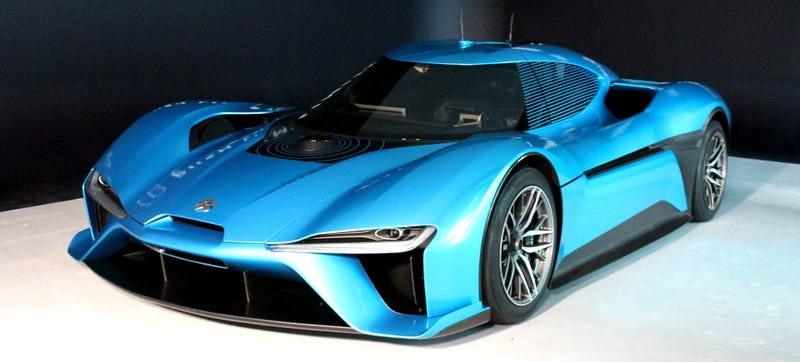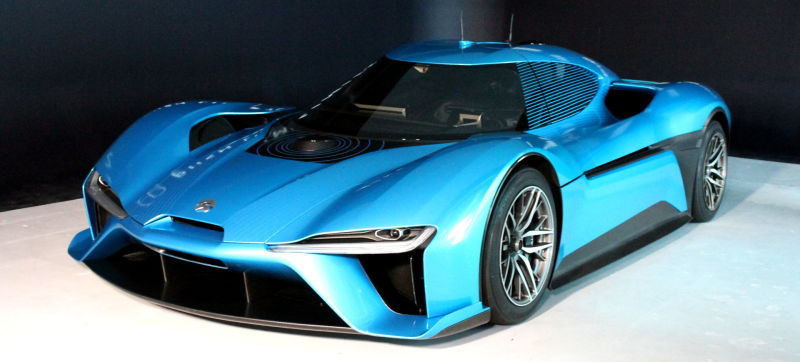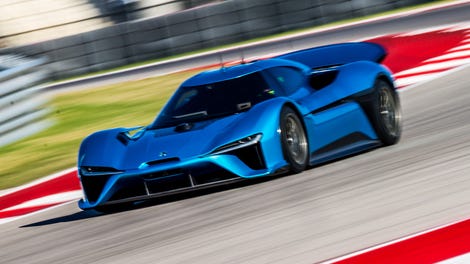
Electric startup NIO released their EP9 supercar with the biggest bang of them all: by setting lap records at the Nürburgring and Circuit of the Americas, with and without a human driver. I had been itching for a closer look at what makes this autonomous machine so fast, so I picked the brains of their test driver and engineering team when NIO brought their car to Austin for SXSW.
NIO says the EP9 came together in just four months, with only five weeks of testing in the United Kingdom before it started its quest for lap time domination at the Nürburgring. They claim the EP9 met its goal of becoming the fastest autonomous car ever made, even if it won’t be sold with the autonomous features used to set its record at COTA.
“People want to drive a supercar,” NIO test driver Aaron Bailey told Jalopnik about the rationale for leaving autonomous features off its production EP9. Bailey also serves as NIO’s manager of chassis systems and driving dynamics, so he does some double duty making the cars handle right and testing them as well.
The autonomous work done with the EP9 won’t go to waste, though. The Eve concept car NIO featured at SXSW was all about how to give commuters back the time they spend getting places through autonomous technology, and that design is closely related to the autonomous electric car company representatives claim is under development for 2020.
The EP9 Is Thisclose To Being A Race Car
While yes, the EP9 is a real car that you can buy, NIO is definitely stretching the definition of “production car.” It’s based on an FIA-spec carbon fiber monocoque for a Le Mans prototype, for one.
Advertisement
Advertisement
The seating position low in said tub is exactly what you’d expect from a Le Mans prototype as well. A foam seat insert covered in tape was made to hold Bailey in place in the lightly padded seat-shaped indentation in the carbon fiber tub.
Bailey also said that the car drives more like a prototype than a regular car, and that you have to keep your foot down on the throttle more than you’d expect to make its aerodynamics work.
Insane amounts of downforce are generated by the big air channels that run underneath the car. You can see daylight from the other side if you bend over and look down one.
It is still an electric car, though—complete with two pedals and no gears.
Sponsored
It also comes with a fully adjustable suspension, and an F1-style, button-activated drag reduction system. The rear wing flattens out for one level of DRS, and for really long straights, they have something Bailey called “Super DRS” where the wing moves down and back. The wing pops back up under braking to give the car more downforce as it approaches a turn.
The car also predates NIO’s rebrand from its old name, NextEV, and you can see some curious branded items on NIO’s EP9. The brake calipers say “NextEV” across them and they even got custom tires that say “NextEV.” The car has massive carbon-ceramic disc brakes designed for long life on track.
The EP9’s tires will no doubt raise a few eyebrows among those who obsessively track lap records: they’re ooey, gooey racing slicks. The tires on display at SXSW were the same ones used to set their lap times at COTA and the Nürburgring.
Advertisement
Advertisement
That being said, Bailey confirmed that the slicks—branded with NextEV but made by a well-known tire manufacturer he wouldn’t specify—were the default tire that comes on one of two sets of wheels that come with the car. EP9s are shipped with 19-inch wheels with racing slicks and 21-inch wheels with a more conventional grooved tire.
While that may upset the “Nürburgring times should be on street tires only” crowd, at least NIO knows exactly what you’re going to use the EP9 for.
It’s All About The Temperatures
We’ve all known that one guy who gets super-excited to go track his Tesla Model S only to discover “limp mode” when the batteries get too hot. Most production EVs aren’t made for track use, and therefore heat up too fast when run hard for a prolonged period of time. Heat was yet another concern of the NIO crew when they went to seek hero-lap glory.
Advertisement
Batteries have a heat limit—that’s why roadgoing EVs have such a reputation for going home early at track days. While the EP9’s batteries were designed for motorsport, Bailey said that the team ran them at only 70% of their potential power in order to set the records at COTA.
Bailey believes the car is capable of running a lap time within five seconds of a full-on LMP2-class Le Mans prototype with the batteries at full power, however, they would have gotten very hot if they tried that. Given that the car is one of three at the moment, it didn’t make sense to risk overheating the car.
Programming Challenges
Bailey said NIO sourced the sensors and controller “box” from another company—he didn’t say which one—but did the autonomous programming for the EP9 entirely in-house. Additionally, hardware was added to control the hydraulic brakes, with the brake actuator mounted on the floor inside the car. An electric motor was added to the steering column under a carbon fiber cover to steer the car without a person behind the wheel. These actuators were also designed by NIO themselves.
Advertisement
Advertisement
To get the EP9’s programming spot on before unleashing the car, Bailey drove the inside and outside edges of the track to teach the car’s GPS where the track was. Then he ripped out a few full-speed laps behind the wheel to teach the car where the racing line was around that newly defined strip of tarmac, reviewing each session afterwards to point out where he was off the line on track. When everyone was satisfied that they had the right line around the track down, it became up to the car to mimic Bailey’s line as best it could.
One of the programmers who worked on the EP9, Kamran Turkoglu, claimed that the car calculates commands every 2.5 milliseconds in order to stay on a smooth enough trajectory for track work.
The car is programmed to recognize things like the amount of yaw (or rotation) it’s experiencing in a turn, and is programmed to know when it’s over its own limits. Multiple failure modes had also been programmed in just in case something went wrong.
Advertisement
That being said, the programming for an autonomous lap had to be so precise that even the extra weight of a driver sitting behind the wheel had to be factored in.
Unfortunately, NIO unleashed the EP9 with Bailey behind the wheel to test how well its autonomous programming was learning the track only to have the car’s programming lose the back end and oversteer into a wall at COTA. The car tried to countersteer to correct, as you can see in their video above, but it hadn’t been programmed to account for the extra inertia provided by the weight of Bailey’s body in to the car.
Bailey said that the NIO team actually held the EP9 back a bit on its driverless run out of fear of binning one of their only EP9s. It still reached a top speed of 160 mph, but that was a full 10 mph under the top speed of the lap set with Bailey behind the wheel.
Advertisement
Advertisement
Bailey claimed that the car had driven itself 10 seconds faster without official timing when he was in the car, however, no official timing was running during that lap, so it didn’t count, and they couldn’t use that time. A transponder mount was still attached underneath the EP9 when it was on display.
When it finally came time to release the car on its own, they first had to set it to a specific “autonomous mode” power map using a switch on the steering wheel. Once Bailey radioed to the rest of the NIO team that he was at a safe distance away from the car, they switched on a safety switch that allowed the car to run on its own.
“We didn’t want to automate the vehicle sensing me leaving the car due to risk and potential injury,” Bailey noted.
Advertisement
It was still pretty freaky for Bailey to see the car his team had worked so hard to finish climb COTA’s steep Turn 1 without him. He said he kept his helmet on for the entire lap—in part because he didn’t know what would happen with the car running out there by itself, but also in case he started tearing up.
NIO Wanted To Prove They Make Cars By Making This Car
NIO has finished and sold three of EP9s already, and currently plans on building six, although more demand for the car could convince them to build more. They cost $1.2 million to build, so speed’s not cheap—but short of someone showing up to the track with a Le Mans prototype, it’s safe to say you’ll “win” the track day. The company plans to release its pricing and sales policy this spring.
Why should car people who aren’t sold on electrification care? That’s a question I asked Bailey, as he’d been racing since he was 11, went into mechanical engineering in college to be able to keep working with cars and definitely spoke our language.
Advertisement
Advertisement
“It broke the McLaren P1 lap record by 6 seconds around COTA,” Bailey replied, referring to the lap he drove.
A lot of hybrid haters dropped their snobbery after the “holy trinity” of the P1, Ferrari LaFerrari and Porsche 918 came out and started breaking lap records. Full-electric cars are next, and they seem poised to do amazing things with or without humans behind the wheel.
















